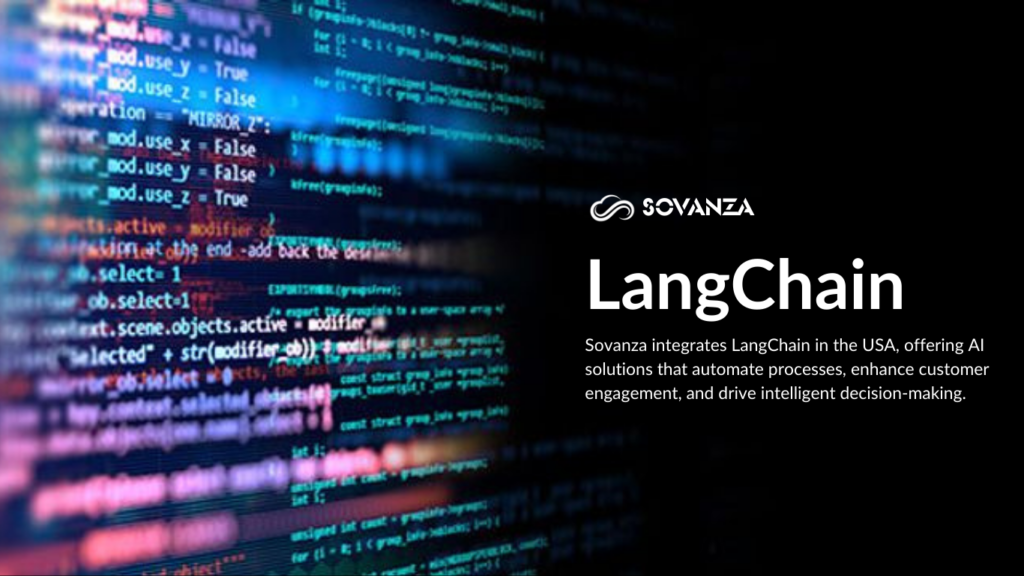
Introduction
LangChain is a groundbreaking open-source framework that empowers businesses to harness the power of Large Language Models (LLMs) such as OpenAI’s GPT, Google’s Gemini, and Meta’s LLaMA. By offering seamless integration with various data sources, tools, and APIs, LangChain simplifies the development of AI-driven applications that automate tasks, enhance decision-making, and improve customer experiences. With its modular design, businesses can build highly customized and scalable applications. It enables businesses to build intelligent and dynamic AI-driven applications.
Sovanza is a leading technology solutions provider specializing in implementing cutting-edge AI-powered solutions. Our team is dedicated to helping businesses unlock the full potential of AI by integrating LangChain into their operations. With a focus on automation, AI-driven customer support, and advanced data processing, Sovanza ensures that businesses can thrive in the competitive landscape of the USA. Our expertise allows us to deliver customized, future-proof AI solutions that drive industry efficiency, growth, and innovation.
What is LangChain?
LangChain is an open-source framework for developing AI applications using LLMs such as OpenAI’s GPT, Google’s Gemini, and Meta’s LLaMA. LangChain’s modular and flexible architecture enables developers to design robust AI-driven processes that improve automation, decision-making, and conversational interactions.
Key Features of LangChain
- Seamless LLM Integration – It connects with multiple LLM providers, enabling businesses to use AI models that best suit their needs.
- Memory and Context Handling – Unlike traditional AI models, it retains conversational context, making interactions more human-like and intelligent.
- Tool and API Connectivity integrate external tools, databases, and APIs, allowing businesses to build AI-powered automation solutions.
- Prompt Engineering Capabilities – It simplifies prompt design and optimization, ensuring AI models generate accurate and relevant responses.
- Scalability & Customization – Businesses can customize LangChain workflows to meet specific industry requirements, from customer support chatbots to complex analytical tools.
How LangChain Works?
It is a structure for developing AI applications that connect large language models (LLMs) to various tools, APIs, and data sources. It breaks down AI-powered operations into essential components, enabling enterprises to create intelligent and flexible apps.
Large Language Model (LLM) Integration
LangChain connects with advanced AI models like OpenAI’s GPT, Google’s Gemini, and Meta’s LLaMA. These models process natural language inputs and generate intelligent responses, enabling applications like AI chatbots, content generators, and automated decision-making systems.
Memory for Context Retention
Unlike traditional AI models that forget previous interactions, It includes a memory component that allows applications to retain context across conversations. It improves the accuracy and relevance of AI-generated responses, making interactions more human-like.
Tool & API Connectivity
It enhances AI capabilities by integrating external tools, APIs, and databases. For example, it can retrieve live data from the internet, interact with customer databases, or execute specific commands, making AI more dynamic and actionable.
Prompt Engineering & Optimization
LangChain helps developers create structured and optimized prompts that improve the quality of AI outputs. By fine-tuning prompts, businesses can ensure that their AI models generate more accurate and contextually relevant responses.
Data Processing & Retrieval
LangChain supports retrieval-augmented generation (RAG), which allows AI applications to access and process external knowledge bases. It benefits businesses that require AI to analyze reports, legal documents, customer inquiries, or market trends.
At Sovanza, we specialize in implementing AI-powered solutions to help businesses in the USA unlock AI’s full potential.
Benefits of Sovanza’s LangChain Integration
Enhance automation and decision-making with Sovanza’s expert AI solutions, designed for seamless AI integration and scalability.
Seamless AI Integration
Sovanza ensures that LangChain integrates effortlessly with your existing business systems, databases, and APIs. It enables smooth AI adoption without disrupting operations. By using LangChain’s modular framework, Sovanza customizes AI workflows to meet your unique business needs.
Advanced Automation & Efficiency
Sovanza automates repetitive tasks, enhances workflow efficiency, and reduces manual workload. AI-driven automation streamlines processes like customer support, data analysis, and decision-making, leading to faster operations, cost savings, and improved productivity.
Intelligent & Context-Aware AI
Sovanza utilizes LangChain’s memory and context-handling features to build AI models that retain and understand past interactions. It makes AI-driven chatbots and applications more human-like and relevant. Businesses benefit from enhanced customer engagement and more intelligent AI responses.
Scalable & Future-Proof AI Solutions
Our AI solutions are designed to scale with your business growth. We ensure adaptability, allowing businesses to integrate new AI advancements without significant disruptions. Sovanza focuses on building relevant AI systems in an evolving digital landscape. It guarantees long-term efficiency, innovation, and competitive advantage.
Enhanced Automation & Business Efficiency
Sovanza helps businesses optimize their operations by automating repetitive and time-consuming tasks. Our AI solutions improve workflow efficiency, reduce costs, and enhance productivity. From AI-powered chatbots to automated data analysis, we ensure seamless business operations, allowing teams to focus on strategic growth and customer engagement.
Why Choose Sovanza for LangChain Implementation?
Choose Sovanza for LangChain implementation to adopt AI-driven solutions that optimize efficiency, scalability, and business growth.
Expertise in AI and LangChain Integration
Sovanza specializes in implementing it for businesses across the USA, ensuring seamless AI integration. Our AI experts leverage LangChain’s advanced capabilities to develop custom AI applications, chatbots, and automation solutions. With deep industry knowledge, we provide tailored AI strategies that align with your business goals.
Customized AI Solutions for Every Industry
We understand that every business has unique needs, so Sovanza develops personalized AI solutions using it. Whether you need an AI-powered customer support chatbot, automated callbot, or data analytics assistant, we build scalable applications to enhance efficiency and productivity.
End-to-End AI Development & Support
Sovanza provides a comprehensive AI development process, from initial consultation and model fine-tuning to deployment and continuous optimization. We ensure smooth integration with your existing systems and offer ongoing support and updates to keep your LangChain-powered AI running efficiently.
Trusted AI Partner for Businesses in the USA
Sovanza is committed to helping businesses nationwide leverage LangChain for growth. Our AI-driven solutions enhance automation, streamline operations, and improve decision-making, giving companies a competitive edge in today’s fast-evolving digital landscape.
Get Started with Sovanza for LangChain Solutions
Contact us today to begin your journey with Sovanza’s AI solutions. Our team will evaluate your company’s requirements and create a customized, scalable solution. We’ll walk you through the seamless integration process with minimal disturbance. We’ll use cutting-edge AI to empower your business by automating tasks and improving client interaction. Use LangChain’s features to increase decision-making, workflow efficiency, and productivity. Let Sovanza assist you in realizing the full potential of AI-driven transformation.
Conclusion
In conclusion, LangChain is revolutionizing how businesses leverage Large Language Models (LLMs) to create intelligent, scalable, and efficient AI-driven applications. Its seamless integration, context retention, and extensive tool connectivity allow businesses to build customized solutions that drive automation, enhance decision-making, and improve customer experiences. By utilizing LangChain, companies can unlock the full potential of AI and remain competitive in today’s fast-paced digital landscape.
At Sovanza, we specialize in implementing AI-powered solutions that transform business operations across industries. Our expertise ensures seamless integration, enhanced automation, and secure, future-proof AI solutions tailored to your needs. Partner with Sovanza to harness the power of AI and take your business to the next level with cutting-edge AI-driven applications.
FAQs
What is LangChain?
LangChain is an open-source framework for building AI applications using large language models (LLMs) like GPT, Gemini, and LLaMA. It integrates data sources, APIs, and external tools.
Why should businesses use LangChain?
It helps businesses automate complex tasks, improve decision-making, and create personalized customer experiences. Its scalability makes it adaptable for growth and industry-specific needs. Seamless AI integration improves operational efficiency and enhances customer engagement.
What industries can benefit from LangChain?
LangChain benefits industries like finance, healthcare, e-commerce, and customer service by automating processes and improving decision-making.
Why should I choose Sovanza for LangChain solutions?
Sovanza offers expertise in AI-driven automation, scalability, and seamless integration. We focus on delivering tailored solutions that ensure security, compliance, and adaptability to meet your business’s evolving needs.
Is Sovanza’s AI implementation secure?
Yes, Sovanza prioritizes security and compliance in all AI implementations. Our LangChain solutions are designed to safeguard sensitive business data, ensuring privacy and protection against cyber threats while maintaining regulatory compliance.

